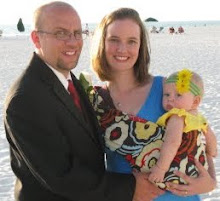When it arrived we took it out of the box to let Laurel try it out. Needless to say, she found it hilarious that she was sitting in her carseat in the middle of the living room.

 We are planning to leave Laurel rear-facing in her carseat until she meets the height or weight limits of the seat (35 pounds and 49"). There are so many safety benefits to continued rear-facing past the minimum legal limits of one year old and 20 pounds. Here are some from http://www.car-safety.org/ and The American Academy of Pediatrics:
We are planning to leave Laurel rear-facing in her carseat until she meets the height or weight limits of the seat (35 pounds and 49"). There are so many safety benefits to continued rear-facing past the minimum legal limits of one year old and 20 pounds. Here are some from http://www.car-safety.org/ and The American Academy of Pediatrics:- Rear-facing is safest for both adults and children, but especially for babies, who would face a greater risk of spinal cord injury in a front-facing carseat during a frontal crash.
- Rear-facing car seats spread frontal crash forces over the whole area of a child's back, head and neck; they also prevent the head from snapping relative to the body in a frontal crash.
- Rear-facing carseats may not be quite as effective in a rear end crash, but severe frontal and frontal offset crashes are far more frequent and far more severe than severe rear end crashes. (According to Crashtest.Com, frontal and frontal offset crashes combine for about 72% of severe crashes. Side impacts are about 24%. Rear and rear offset crashes only account for about 4%.)
- Rear-facing carseats are NOT a safety risk just because a child's legs are bent at the knees or because they can touch/kick the vehicle seat.
- Rear-facing as long as possible is the recommendation of the American Academy of Pediatricians, and can reduce injuries and deaths. Motor Vehicle Crashes are the #1 overall cause of death for children 14 and under.
Here are some videos that demonstrate a child in a forward-facing carseat and what happens to their body during a crash, versus a child in a rear-facing carseat in a crash.
For our family, reaching the next "milestone" by turning Laurel's carseat forward is something that can wait!





2 comments:
Thanks for keeping our precious granddaughter safe!
So glad you posted the videos. We've been talking about this for a while. It's better for us err on the side of caution and keep our girls rear-facing!
Post a Comment